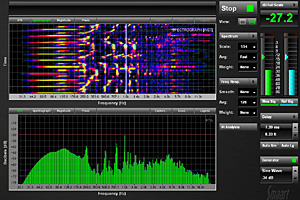Question posted by Patrik Arnekvist on September 17, 2001
I know there’s a lot of Smaart experts here so here goes a thought. When using the delay locator, Smaart assumes that the right delay setting is at the highest peak of the waveform. At low frequencies – is that really the right thing to do, I mean the “waveform” starts at a zero energy level..or? At 40 hz, there is some time between zero and top of the impulse. (Does Smaart use the same peak as the reference?) I experimented with it, and did a measurement of a 2 way crossover going directly into Smaart with no delay applied. Smaart wanted to delay the low output. Why? I also couldn’t get a coherent phase response with no delay on the low output. How does smaart analyse the phase response? I also wonder what the difference is between 0 deg and 360 deg, is it only time dependent?
Reply posted by Paul Tucci on September 17, 2001
– “When using the delay locator, Smaart assumes that the right delay setting is at the highest peak of the waveform.” For an Impulse Alignment, yes, the peak is the right thing to use. For a smooth phase through acoustic crossover area alignment, it may NOT be the right timing. There are choices to be made about what to do with the info Smaart gives us.
– “At low frequencies, is that really the right thing to do? I mean the “waveform” starts at a zero energy level..or?” At 40 hz there is some time between zero and top of the impulse.” Correct, and insightful.
– “I experimented with it, and did a measurement of a 2 way crossover going directly into Smaart with no delay applied. Smaart wanted to delay the low output. Why?” I did this same experiment and scratched my head for months. Its called group delay. The low pass filter in the crossover causes some things to happen. Higher frequencies are rolled off at a chosen db/octave at a certain frequency. That’s the understandable part. The PHASE shift caused by the crossover, and this is just a fact of life one cannot avoid, is problematic. Yes, it is in fact delaying the low frequency output. That’s why you measured it that way and that’s why Smaart’s phase trace was incoherent until you added the proper delay to synchronize your measurement. Smaart gives you some good clues to tell you when measurements are bad. I am parent on duty this Am so I must run. I’m glad to see all these Smaart questions coming up now. I suggest to the powers that be that a Smaart-centered live chat is in order. I’ll elaborate more later.
Reply posted by Patrik Arnekvist on September 17, 2001
Thanks for your response. The thing is also, when I delayed the low output , I got a deep cancellation at the crossover point, if it all were in phase, why would that happen?
Reply posted by Paul Tucci on September 18, 2001
“The thing is also, when I delayed the low output , I got a deep cancellation at the crossover point, if it all were in phase, why would that happen?” Your choice of wording is curious. You say Smaart wanted to delay the low end. Do you mean to say Smaart measured a time difference between the reference side of your equation and the output of your xover? That would be normal. The delay would go on the reference side because you want to have compare the two when they are synchronous. “Row, row, row, your boat” vs “gently down the stream” does not a valid comparison make. Understand the analogy?
If you introduced delay onto the measurement side of the equation, ie, the low xover out, you made an even more invalid comparison. This would explain your lack of coherence. You may have created the transversal equalizer responsible for the notch described by comparing the same signal to itself, though one is offset in time at twice the wave period of your notch frequency. That’s a mouthful. Then again, if you didn’t include the throughput delay of the digital (?) xover (approximately one millisecond)in your measurement, a 500 hz notch (1/2 of 1000hz or one millisecond of time) would appear. Could go either way.
Reply posted by Earl Driggers on September 17, 2001
Keeping in mind that phase is time and time is phase, by delaying the low output the relative phase between the two outputs is probably 180^( or close ) now. Another thing to keep in mind is that phase/time misallignment will only effect the frequencies common to both outputs. Now that the delay time is correct on the outputs, having to invert the phase on one of the outputs is a common occurance.















